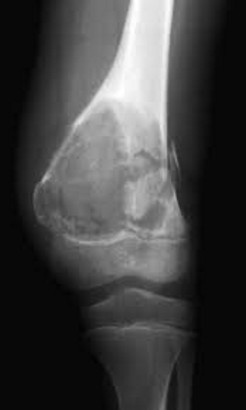Benign bone tumor, representing around 1 % of all bone tumors. It is a cystic lesion consisting of blood-filled cavities divided by fibrous septa containing fibroblasts, multinucleated osteoclastic giant cells and “woven” bone tissue. The disease mainly affects adolescents and young adults. The most common sites are the femur (22 %), tibia (17 %), spine (15 %), humerus (10 %), pelvis (9 %) and fibula (9 %). Pain and swelling are the most frequent signs. In case of vertebral involvement (posterior arch of vertebral bodies), patients may present neurological symptoms due to compression of nerve roots of the medulla.
A distinction is made between :
- primary aneurysmal cyst (70 % of cases): a specific chromosomal translocation, 17p11-13 or 16q22 involving TRE17/USP6 (ubiquitin-specific protease) has been described
- secondary aneurysmal cyst (30 %): secondary to hemorrhage in a pre-existing tumour such as essential bone cyst, chondroblastoma, giant cell tumour, osteoblastoma, chondromyxoid fibroma, non-ossifying fibroma, fibrous dysplasia or telangiectatic sarcoma.

On X-ray: the tumor area is usually well circumscribed and eccentric; the periosteum becomes enlarged (ballooned), extending into the soft tissue, and may be surrounded by neoformed bone tissue. MRI typically shows fluid levels (separating fluids of different densities).
The natural history of aneurysmal cyst is divided into 4 phases: lytic, expansive, stabilization and healing. Although benign, this lesion is highly aggressive, making it difficult to treat.
For a long time, the classic treatment was curettage with or without adjuvants, plus or minus grafting, with a recurrence rate of around 30 %. Today, sclerotherapy or selective arterial embolization, or even drug therapy, is recommended as first-line treatment. A biopsy-confirmed aneurysmal bone cyst can be injected with doxycycline, albumin and air to form an injectable foam. More than one or two injections may be necessary. Other alcohol-based sclerosing agents have been used. Radiotherapy may be the treatment of choice for spinal lesions that are completely inaccessible to surgery and compress the spinal cord.
Anesthetic implications:
depending on cyst location
References :
-
Updated: March 2025